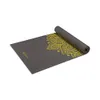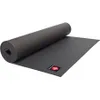
The puppy pose is called Uttana Shishosana in Sanskrit — it’s a popular yoga pose known as "heart-melting," stretching the upper body muscles, including those that support and surround the spine. I gave three minutes of my day to do the puppy pose for one week, and here’s what I learned.
You can look no further if your goal is to find a stretch that combines a child’s pose and a downward-facing dog. Extended puppy pose targets your arms, shoulders, chest, abdomen and back, and to do it, you’ll start on your knees with your hips stacked directly over them, then walk your hands forward and draw your chest and head toward your mat.
Simple enough. I added the exercise to my daily routine, spending three minutes in the pose and noting anything I experienced in my body, physically and mentally, along the way. Plus, all I needed was one of the best yoga mats and a bit of space to get started.
How to do puppy pose for beginners
The puppy pose is suitable for beginners, but if you have tight shoulders or back pain, ease slowly into the pose and scale where necessary — we include a few options below.
If you’re unsure whether puppy pose suits you, speak with a certified yoga instructor or a physician before starting any new exercise, and stop if you experience sharp and persistent pain.
How:
- Start on all fours in a tabletop position with your shoulders over your wrists and hips over your knees.
- Walk your hands forward while keeping your hips stacked over your knees.
- Keep your arms engaged as you stretch your hands away from you and ensure the elbows stay lifted away from the floor.
- Slowly lower your forehead to the mat and relax your chest toward the ground.
- Press gently through your hands and hold the stretch.
To achieve a deeper stretch, walk your hands further forward and lower your chin to the mat, sending your gaze forward. To reduce the intensity, position a bolster, yoga block, or blanket beneath your chest, elbows, or forehead. Anyone with sore knees can position a rolled-up mat or blanket beneath both legs.
Sign up to get the BEST of Tom's Guide direct to your inbox.
Get instant access to breaking news, the hottest reviews, great deals and helpful tips.
I did the 3-minute puppy pose exercise every day for one week — here are the results
Here’s what happened.
It's deeply relaxing if you can stick with it
Whenever my yoga instructor cues an extended puppy pose, I am delighted. Surprisingly, I hadn’t considered adding this exercise to my routine before now, but it felt best suited for my morning routine when I’m most frantic and need to slow down.
The stretch is perfect for releasing tension in the shoulders, chest, abdomen and spine and only requires three minutes of my time, helping me wake up my body for the day ahead. In that way, it's a bit like using a short breathing exercise to boost your mental strength and reduce stress.
Despite lasting only three minutes, it helped me sit still in my mind and body, and the overall experience alleviated physical and mental tension — I focused on my breath, using every exhale to sit deeper into the stretch until my chin rested comfortably on the mat beneath me. Afterward, I definitely felt calmer.
I had to practice deep breathing
As with all stretches, breathing is crucial to help the body relax into the posture and release tension from tight muscles. I’ve previously practiced melting into a 3-minute butterfly pose and a 3-minute frog pose and learned during both just how crucial “belly breathing” can be for maintaining the posture and staying patient.
I practiced an expansive breathing method that I’ve learned from Pilates and yoga, sending my breath to my back and stomach and expanding my ribcage. During a yoga class, instructors encourage you to seal your lips, then inhale and exhale through your nose. Instead, I used each exhale to sigh through my mouth; Harvard Health says the breathing technique lowers heart rate, increases oxygen exchange, and reduces stress levels.
Extended puppy pose for beginners might feel limiting for the breath, but I recommend finding a position you can hold and breathe calmly without pain.
My spine and shoulders thanked me
Much of the current research (including this study in the International Journal of Yoga) tells us that regular yoga practice could improve gait, posture, balance and flexibility, amongst other benefits. Combining extended puppy pose with my existing weekly yoga practice helped open my shoulders, release tension in my chest and back and temporarily improve upper body mobility before jumping into my day.
The positive effects of the puppy pose have proved more mental than physical for me throughout the week, but my chest, back and shoulders held less tension, and I temporarily had more range in my upper body. But as I’ve learned from my experience as a fitness professional and from stretching with the guys at the infamous StretchLab recently, even the deepest stretches only offer a short-term flexibility boost.
You’d need to instill a regular stretching and mobility routine to see the long-term benefits, like improving movement efficiency and muscle engagement. If you're not sure where to start, these stretches for beginners are a great way to boost flexibility in your legs.
I did the 3-minute puppy pose exercise every day for one week — here’s my verdict
As with many stretching regimes, results can be immediate yet short-lasting. I could sink deeper into extended puppy pose much more quickly by day seven; to develop a stronger shoulder opener, I positioned my forearms on two yoga blocks, which created more distance between my upper body and the mat.
Throughout the week, I experienced better mental clarity and calmness heading into my day. It makes sense, as three minutes of stillness, coupled with breathing exercises and releasing muscle tension, acts as a form of meditation.
But as with many of our Tom’s Guide fitness challenges, we’ll never promote drastic changes in as little as one week. Depending on the exercise undertaken, it may take months or even years to develop notable changes to your body, and results vary from person to person.
However, the Mayo Clinic says stretching could improve flexibility and increase muscle blood flow, which can translate to other daily activities. You may notice an initial positive impact fairly quickly if you suffer from particularly tight muscles, which I did.
I’ve loved waking up to extended puppy pose every day, and if you inadvertently spend long hours at your desk like me, your upper body might just love you for giving it some TLC.
More from Tom's Guide
- Does yoga build muscle?
- I've been teaching weightlifting for years, 3 ways to build strength and muscle with light weights
- Forget triceps dips, I did kettlebell skull crushers every day for a week, here's what happened

Sam Hopes is a level 3 qualified trainer, level 2 reiki practitioner and senior fitness writer at Tom's Guide. She is also currently undertaking her Yoga For Athletes training course. Sam has written for various fitness brands and websites over the years and has experience across brands at Future such as Live Science, Fit&Well, Coach, and T3.
Having worked with fitness studios like F45 and Virgin Active, Sam now primarily teaches outdoor bootcamps, bodyweight, calisthenics and kettlebells. She also coaches mobility and stretching-focused classes several times a week and believes that true strength comes from a holistic approach to training your body.
Sam has completed two mixed doubles Hyrox competitions in London and the Netherlands and finished her first doubles attempt in 1:11.









